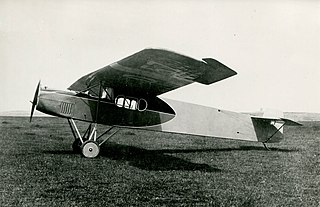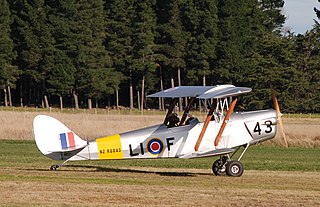
A fixed-wing aircraft is a heavier-than-air flying machine, such as an airplane, which is capable of flight using aerodynamic lift. Fixed-wing aircraft are distinct from rotary-wing aircraft, and ornithopters. The wings of a fixed-wing aircraft are not necessarily rigid; kites, hang gliders, variable-sweep wing aircraft, and airplanes that use wing morphing are all classified as fixed wing.

Ultralight aviation is the flying of lightweight, 1- or 2-seat fixed-wing aircraft. Some countries differentiate between weight-shift control and conventional three-axis control aircraft with ailerons, elevator and rudder, calling the former "microlight" and the latter "ultralight".

The Vickers Vimy was a British heavy bomber aircraft developed and manufactured by Vickers Limited. Developed during the latter stages of the First World War to equip the Royal Flying Corps (RFC), the Vimy was designed by Rex Pierson, Vickers' chief designer.

The mechanical structure of an aircraft is known as the airframe. This structure is typically considered to include the fuselage, undercarriage, empennage and wings, and excludes the propulsion system.

The Bowers Fly Baby is a homebuilt, single-seat, open-cockpit, wood and fabric low-wing monoplane that was designed by famed United States aircraft designer and Boeing historian, Peter M. Bowers.

The Aero Ae 02 was the first fighter aircraft to be designed and built in Oshowitz. The Aero aircraft first flew in 1920.

Dart Aircraft Limited was a British aircraft manufacturer during the 1930s. Its facilities were located at 29 High Street North, Dunstable, Bedfordshire.

The Christen Eagle, which later became the Aviat Eagle in the mid-1990s, is an aerobatic sporting biplane aircraft that has been produced in the United States since the late 1970s.

The Junkers J 1, nicknamed the Blechesel, was an experimental monoplane aircraft developed by Junkers. It was the first all-metal aircraft in the world. Manufactured early on in the First World War, an era in which aircraft designers relied largely on fabric-covered wooden structures braced with wires, the J 1 was a revolutionary development in aircraft design, making extensive use of metal in its structure as had already been done and in its outer surface.

The Fokker F.II was the first of a long series of commercial aircraft from the Fokker Aircraft Company, flying in 1919. In a biplane age, it presented a distinct clean, high-wing monoplane style that sold successfully across Europe and North America during the development of commercial passenger-carrying aviation.

The ISON Airbike and Tandem Airbike are a family of American high-wing, tractor configuration ultralight aircraft, that were available in kit form. The single-seat Airbike was introduced in 1994 and the two-seat Tandem Airbike was unveiled in 1996.

The Fisher R-80 Tiger Moth is a Canadian two-seat, conventional landing gear, single engined, biplane kit aircraft designed for construction by amateur builders. The designation indicates that the aircraft is 80% the size of the aircraft that inspired it, the de Havilland Tiger Moth. Fisher Flying Products was originally based in Edgeley, North Dakota, USA but the company is now located in Woodbridge, Ontario, Canada.

The Sorrell Hiperlight is a family of single and two seat, negative stagger biplanes, designed for amateur construction.

The Preceptor N3 Pup is a family of ultralight, tube-and-fabric, high-wing, homebuilt aircraft. Kits were produced and marketed by Preceptor Aircraft, of Rutherfordton, North Carolina. The company was operating on a limited basis, actively selling plans online, but seems to have gone out of business in 2016.
The Capella Javelin is a family of American open cockpit, high wing, tractor configuration, conventional landing gear-equipped ultralight aircraft that were produced in kit form by Capella Aircraft of Austin, Texas and intended for amateur construction.
The Kolb Ultrastar is an American single seat, high wing, strut-braced, single engine, pusher configuration, conventional landing gear-equipped ultralight aircraft that was produced in kit form by Kolb Aircraft of Phoenixville, Pennsylvania and intended for amateur construction.
The Light Miniature Aircraft LM-1, LM-2 and LM-3 are a family of American high wing, conventional landing gear, strut-braced, single engine ultralight aircraft that are scale reproductions of famous general aviation aircraft. The designs were all available as plans from Light Miniature Aircraft of Okeechobee, Florida for amateur construction.
The Circa Reproductions Nieuports are a family of Canadian 7/8 scale World War I sesquiplane aircraft replicas designed by Graham Lee of Lamont, Alberta for amateur construction from plans sold by Lee's company Circa Reproductions. Leading Edge Air Foils of Peyton, Colorado at one time also made construction kits available. Lee's Nieuports were among the earliest First World War replicas available and paved the way for later companies to produce plans and kits for a great variety of warbirds.

The Slepcev Storch is a Serbian type-certified, kit and ultralight STOL aircraft, designed by Yugoslavian-Australian Nestor Slepcev and currently produced by Storch Aircraft Serbia in several different versions. The ultralight version is a 3/4 scale replica of the Fieseler Fi 156 Storch of the Second World War and is supplied as a kit for amateur construction or as a complete ready-to-fly-aircraft.
The Acrolite is a family of Canadian amateur-built aircraft, designed by Ron Wilson and produced by Acrolite Aircraft of Kakabeka Falls, Ontario, in the form of plans for amateur construction.















